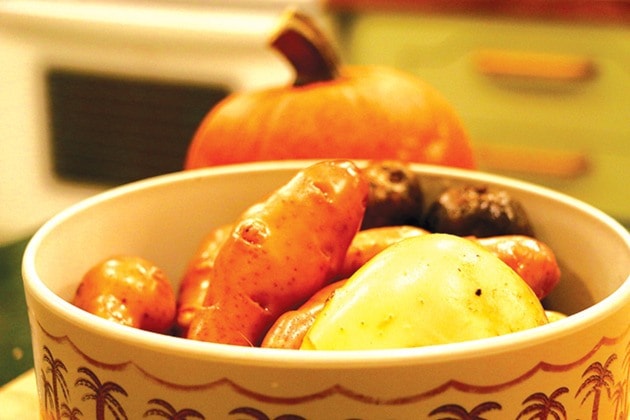They arrived in the mail – one large paper bag with four smaller paper bags inside, each holding a few heritage seed potatoes.
“Now what I am supposed to do?” I asked.
“Cut them up, so that each piece has an eye, and then you plant them one foot apart,” said a friend of mine.
“Seems easy enough,” I said.
That weekend I wrapped string around one post and then another fifty feet away so as to have straight rows. It didn’t work. I tried again, two more times. All three rows were wonky. It looked like I had been under the influence.
An hour later, I had 150 feet of seed potatoes planted: Russian Blue, Irish Cobbler, Banana Fingerling, and Pink Fir Apple Fingerling.
“Now what I am supposed to do?” I asked.
“Now you wait,” was the answer.
Every so often I get some random romantic notion in my head. When I was younger, I decided I would abandon society and live in the forest, until I realized that the forest was cold and dark and wet. A few years ago, I decided to learn the violin. I got discouraged when it still sounded like two cats fighting after several months of practicing. This year I had the idea to plant potatoes.
They say that ignorance is bliss. This is certainly the case with farming. I had no idea what I was doing – how long it took to grow potatoes, how these varieties might taste, or what else was required of me to get them to the kitchen counter several months later.
It was exciting to see the plants pop out of the soil, and the leaves unfurl. It was not as exciting, however, when I was told that I had to start ‘hilling’ the rows. This involved manual labour, and I’m not fond of manual labour. It’s one of the reasons I became a teacher, then a writer. Halfway down the first row, I developed blisters. “Well, this sucks,” I said to the neighbourhood cat that came to say hello.
Every couple weeks, I made my way down the length of the fifty-foot rows. I had to shift the wooden handle of the hoe in my hands, so as not to open the blisters as I scraped the soil before mounting the hill, but I did learn to appreciate the rhythm of it all.
Eventually, it was time to harvest. The Russian Blue and Irish Cobbler are earlier season potatoes, compared to the fingerling varieties, and soon I was pulling up plants and sifting through the soil. I made mashed potatoes and scalloped potatoes, and tried traditional recipes for champ and colcannon. Pulling up one or two plants at a time wasn’t so bad.
Late summer became early fall, and the weather wasn’t as pleasant. The days got shorter and it got colder. Then it rained. A lot. And I was already getting sick of potatoes.
The phone rang last week. “You should think about harvesting them all soon,” said my friend. “They’ll start to rot if it gets too wet, or freeze if it gets too cold.”
Harvesting half a dozen larger potatoes at a time wasn’t difficult, but harvesting the remaining 125 feet of potatoes in one evening – most of the fingerling variety – in the drizzly rain and approaching darkness didn’t sound like a good time.
My wife agreed to help me, but she wasn’t amused that she had to scrape the mud off the shovel every few minutes as I attempted to pull up the sleeves of my wool sweater with my wrists.
“When I mentioned that we should spend more time together, this is not what I meant,” I said as I tried to warm my fingers with my breath.
We filled buckets and buckets with potatoes and, the next day, laid them out to dry. Then we had to clean them. “Suddenly, I see the industrial revolution in a whole new light,” I said.
My wife laughed at me. “You’re probably not doing this again next year, are you?”
“No, probably not,” I answered. “Actually, I was thinking about building a chicken coop – maybe getting some chickens. We could collect eggs in the morning for our breakfast. How does that sound?”
